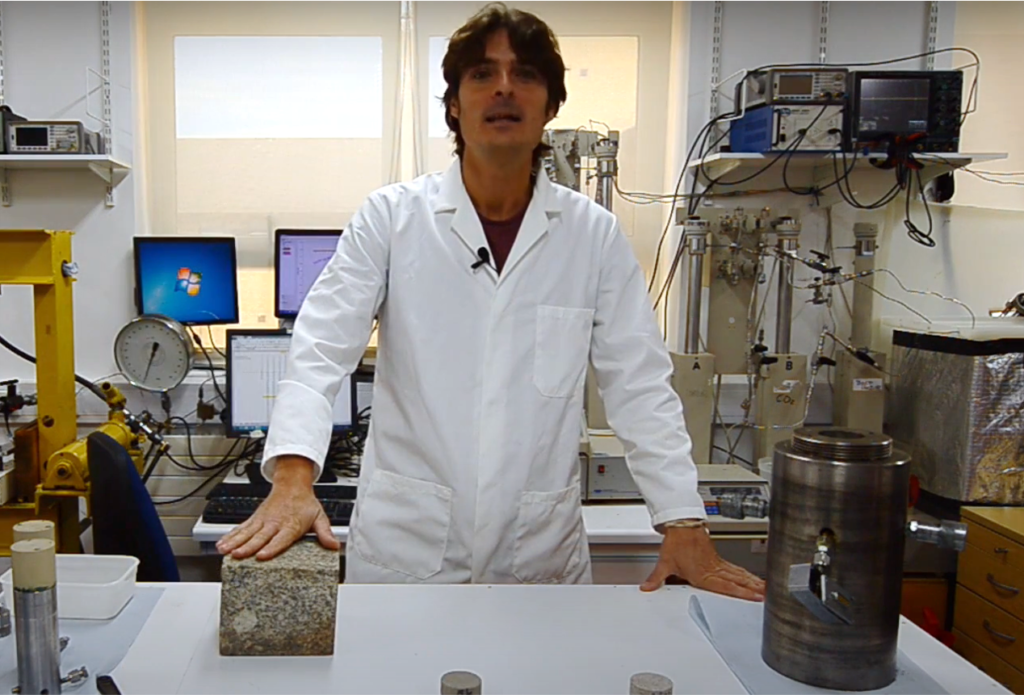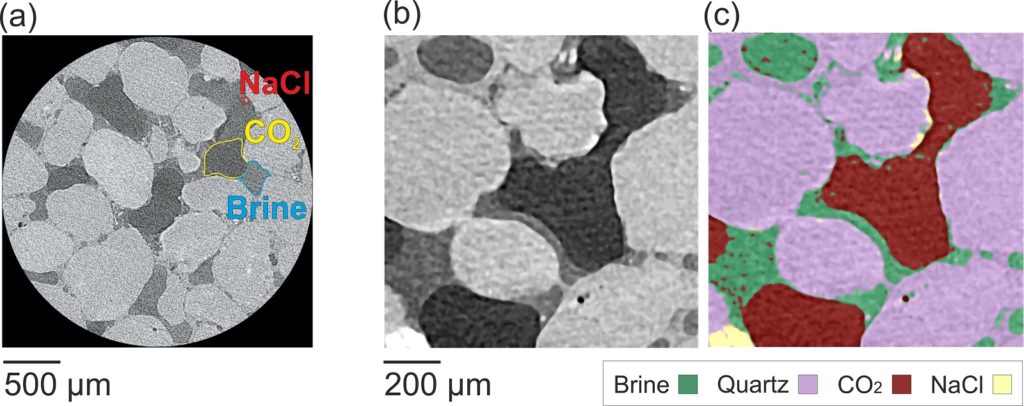Reservoir rocks are of particular interest to geoscientists as they can act as a reservoir for carbon dioxide storage. Carbon capture and storage (CCS) is a process whereby carbon emissions are captured from sources like coal-fired power plants and stored in geological reservoirs so they will not enter the atmosphere.

What is your goal for studying carbon capture and storage (CCS)?
CCS involves the injection of carbon dioxide underground. When carbon dioxide is injected into deep geological formations, it might trigger changes in the host formation and seal rock related to pressure and temperature variations and chemical disequilibria. As a result, the original properties of the reservoir might change. Therefore, the reservoir properties have to be studied in the laboratory, under pressure, temperature and fluid flow controlled simulations, to generate data that can help improve the interpretation of large scale geophysical surveys acquired during CCS monitoring. Our goal is to combine lab and field scale datasets and develop better predictive tools to assess to which extent the geomechanical integrity of the reservoir will be compromised by the carbon dioxide injection.
Dr. Falcon-Suarez and his colleague describe their experimental set-up for studying CCS in the laboratory.
Tell us about your recent publication.
Fluid in deep reservoirs typically has high salinity. When carbon dioxide is injected and displaces the fluid, it has the potential to trigger salt precipitation, which can change the properties of the original reservoir. Therefore, an early detection of this salt precipitation is essential to guarantee both the injectivity and the geomechanical integrity of the reservoir during CCS.
Our recent publication shows that we can predict salt precipitation in the lab from changes in the acoustic and electrical properties of the rock, the two most common geophysical tools for reservoir monitoring used in the field. Then, by comparing changes in rock properties, we also found evidence of rock weathering associated with the carbon dioxide injection.
How did you use X-ray microscopy?
We performed three carbon dioxide flow-through tests in high salinity brine saturated sandstone. The first test was monitored with X-ray microscopy at the Colorado School of Mines (USA); the other two were monitored with geophysical and hydromechanical sensors at the NOCS. From the data, we were able to infer the saturation of salt under specific laboratory conditions. Then, with a twin sample under similar lab controlled conditions, we repeated the test twice. Each of them lasted five days and, surprisingly, both yielded similar results in terms of time until first salt induced geophysical signature and the evolution of the precipitation phenomenon.

Later, we performed a theoretical analysis to assess the salt precipitation process and found a close agreement between our theoretical and experimental data. Thus, we are able to develop a rock physics modelling to quantify the salt saturation from the geophysical record.
How did you use polarized light microscopy and scanning electron microscopy?
Aſter the experiment, thin sections were obtained from both the original and the tested samples and analyzed using polarized light microscopy. The remaining trimmings of the thin sections were to better understand the composition of the salt crystals with scanning electron microscopy and Energy Dispersive X-ray Spectroscopy (EDX).
With the polarized light microscopy image analysis of the thin section pictures, we were able to estimate the salt saturation and precipitation stage. We also examined the patterns that salt crystals were exhibiting (mainly surrounding grains).

The SEM-EDX analysis allowed us to verify that the crystals were mainly halite with just a minor contribution of nahcolite. This information was crucial to infer the micro-porosity of the salt aggregates around the rock grains and relate it to the stage of the salt formation.

Indirectly, this provides information about the speed of the carbon dioxide induced salt precipitation process, which has implications for the effectiveness of common clogging mitigation techniques.
Learn More
Read the full article “Geophysical early warning of salt precipitation during geological carbon sequestration” Link
Learn about ZEISS solutions for X-ray microscopy, scanning electron microscopy, and polarized light microscopy.
Read Next





